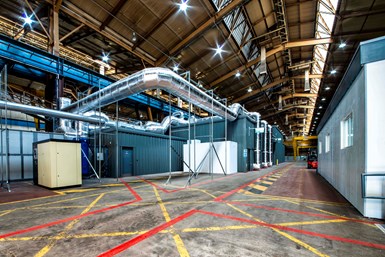Lightweight Manufacturing Centre opens in Scotland
The center, operated by the University of Strathclyde, is set up to develop lighter, more efficient components for automotive and aerospace companies.
The Lightweight Manufacturing Centre (LMC), a £8.9 million center in Renfrew, Scotland and operated by the University of Strathclyde, has recently opened with the goal of helping companies benefit from lightweight manufacturing technology, including composites.

Source | Lightweight Manufacturing Centre
The center, which is the first stage of a £65 million National Manufacturing Institute Scotland that aims to make Scotland a global leader in advanced manufacturing, will develop lighter, more efficient components for high-value industries, including automotive and aerospace, as well as other industries looking to replace traditional manufacturing processes and materials with lightweight solutions.
At the June 26 opening ceremony for the center, which is temporarily located in the Doosan Babcock facility in Renfrew, Scotland First Minister Nicola Sturgeon said, “Our ambition is to build on Scotland’s long history of innovation and to be seen as modern inventors and producers, rather than just consumers of goods. It is really important as technology rapidly advances, that our economy must follow suit. This world-class center will help us do just that, as the first stage of our new National Manufacturing Institute Scotland. Businesses across Scotland will benefit from access to state-of-the-art equipment and opportunities for collaboration and research and development. The opportunities that stem from lightweight manufacturing will help increase their competitiveness.”

Source | Lightweight Manufacturing Centre
“Lightweighting technology holds huge promise for a wide range of sectors, from making aircraft and vehicles lighter and more energy efficient, to improving renewable energy technology performance, and developing the next generation of materials for healthcare,” says Professor Sir Jim McDonald, principal of the University of Strathclyde. “The new center provides the skills and services needed to place Scottish industry at the forefront of lightweight manufacturing, helping companies of all sizes compete globally.”
“Manufacturing is experiencing rapid advances driven by digital technologies, automation and global supply chain opportunities that are transforming the way we design, build and sell products and services,” says David Smith, director of National Opportunities at Scottish Enterprise. “For Scottish manufacturers to remain competitive, it’s increasingly important for them to embrace innovation and adopt new processes and technology. This is exactly how the LMC can help, especially for smaller manufacturers who want easy access to cutting-edge lightweighting expertise and facilities to grow their business.”
“Working with the Lightweight Manufacturing Centre has become an integral part of our plans to develop the next generation of wind turbines blades, the ACT Blade, which aims to reduce cost of wind energy for future generations,” says Sabrina Malpede, managing director of ACT Blade (Edinburgh).
Related Content
-
Recycling end-of-life composite parts: New methods, markets
From infrastructure solutions to consumer products, Polish recycler Anmet and Netherlands-based researchers are developing new methods for repurposing wind turbine blades and other composite parts.
-
Composites end markets: Batteries and fuel cells (2024)
As the number of battery and fuel cell electric vehicles (EVs) grows, so do the opportunities for composites in battery enclosures and components for fuel cells.
-
Hexagon Purus opens new U.S. facility to manufacture composite hydrogen tanks
CW attends the opening of Westminster, Maryland, site and shares the company’s history, vision and leading role in H2 storage systems.

.jpg;width=70;height=70;mode=crop)














